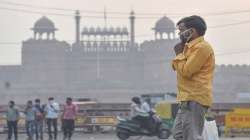Delhi's air quality 'severe', likely to remain so on Diwali
Delhi's air quality deteriorated to 'severe' category on Saturday as Punjab and nearby regions recorded the highest number of stubble burning incidents this season, officials said.

Delhi's air quality deteriorated to 'severe' category on Saturday as Punjab and nearby regions recorded the highest number of stubble burning incidents this season, officials said.
The farm fire count in Punjab, Haryana, Uttar Pradesh, and Uttarakhand stood at 4,528 on Friday, which was the highest this season, the central government's Air Quality Early Warning System for Delhi said, adding that the city's air quality is likely to remain "severe" on Diwali as well.
According to the Central Pollution Control Board (CPCB) mobile app SAMEER, Delhi's overall air quality index (AQI) was 427 on Saturday evening and 443 in the morning.
Experts said while meteorological conditions were "moderately" favourable for dispersion of pollutants, a "very high" number of farm fires in Punjab was the primary reason for the "severe" air quality.
An AQI between zero and 50 is considered "good", 51 and 100 "satisfactory", 101 and 200 "moderate", 201 and 300 "poor", 301 and 400 "very poor", and 401 and 500 "severe".
“The overall AQI has deteriorated to the severe category.
Despite moderate day time dispersion condition, air quality has declined owing to sustained unusually high fire emissions.
Surface winds have become calm today (Saturday) morning and pollutants are accumulating near the surface,” SAFAR said.
It also said that the stubble burning share in PM2.
5 in Delhi's air is estimated as 32 per cent for Saturday.
“Surface winds are forecasted to decrease on November 8 and 9.
No quick recovery is expected unless a drastic reduction in fire counts takes place,” it said.
PM10 levels in Delhi-NCR stood at 486 microgram per cubic meter (ug/m3), according to CPCB data.
PM10 is particulate matter with a diameter of 10 micrometers and inhaled into the lungs.
These particles include dust, pollen and mold spores.
PM10 levels below 100 ug/m3 are considered safe in India.
The levels of PM2.
5 finer particles which can even enter the bloodstream were 292 ug/m3 at 9 am.
PM2.
5 levels up to 60 ug/m3 are considered safe.
It said the AQI is likely to remain in the "upper end of 'very poor' category on November 13 and 'severe' category on November 14 (Diwali)".
According to the India Meteorological Department (IMD), the maximum wind speed was 14 kilometres per hour on Friday and the minimum temperature 11.
8 degrees Celsius.
Calm winds and low temperatures trap pollutants close to the ground, while favourable wind speed helps in their dispersion.
V K Soni, head of IMD's environment monitoring research centre, said, "A very large number of farm fires over Punjab is the primary reason for the severe air quality in the region.
"
SAFAR said the share of stubble burning in Delhi's PM2.
5 pollution was estimated to be 21 per cent on Friday.
It was 42 per cent on Thursday, the maximum so far this season.
Last year, the contribution of stubble burning to Delhi's pollution had peaked to 44 per cent on November 1, according to SAFAR data.